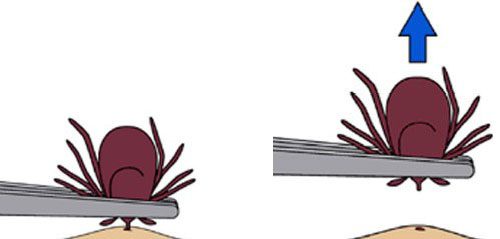By Dave Sanders, Director of Safety and Risk
 Each summer, we remind our field personnel to be aware of an increased presence of pests like mosquitos, bees, and ticks. Many of us are familiar with taking precautions against ticks due to the risk of exposure to Lyme disease. But this year we are facing yet another threat with tick exposure known as the Powassan virus (POW). According to the Center for Disease Control, POW is a rare but often serious disease, with flu-like symptoms including fever, headache, vomiting, weakness, confusion, seizures, and memory loss, although many who are infected with POW do not develop symptoms. The virus can lead to encephalitis (inflammation of the brain) and meningitis (inflammation of the membranes that surround the brain and spinal cord).
Each summer, we remind our field personnel to be aware of an increased presence of pests like mosquitos, bees, and ticks. Many of us are familiar with taking precautions against ticks due to the risk of exposure to Lyme disease. But this year we are facing yet another threat with tick exposure known as the Powassan virus (POW). According to the Center for Disease Control, POW is a rare but often serious disease, with flu-like symptoms including fever, headache, vomiting, weakness, confusion, seizures, and memory loss, although many who are infected with POW do not develop symptoms. The virus can lead to encephalitis (inflammation of the brain) and meningitis (inflammation of the membranes that surround the brain and spinal cord).
How do Ticks Get on a Person?
 Ticks do not jump, crawl, or fall onto a person. They are picked up when your clothing or hair brushes a leaf or other object they are on.
Ticks do not jump, crawl, or fall onto a person. They are picked up when your clothing or hair brushes a leaf or other object they are on.- Ticks are generally found within three feet of the ground.
- Once picked up, they will crawl until they find a favorable site to feed. Often they will find a spot at the back of a knee, near the hairline, or behind the ears.
Precautionary Measures
- When possible, avoid wooded and bushy areas with high grass
- Wear long pants, socks, and long-sleeved shirts. Tuck your shirt into your pants, and tuck pants into socks or boots. Wear a hat and tie back long hair. Wear light-colored clothing so that ticks can be seen more easily.
- Apply insect repellents containing DEET to bare skin
- Clothing and gear can be treated with permethrin, which remains protective through several washings
- After being outdoors, conduct a full-body tick check. Also examine clothing and gear. Be sure to check these areas:
- Parts that bend (back of knee, between fingers and toes, underarms)
- Pressure points where clothing presses against skin (underwear elastic, belts, neck)
- Other common areas (belly button, around or in ear, hairline, top of head)
- Bathe or shower (preferably within 2 hours after being outdoors) to wash off and find ticks on your body. Find and remove ticks immediately before they have a chance to bite and attach.
- Place clothing worn in tick-infested areas into the dryer for at least 30 minutes in order to kill any ticks.
How to Safely Remove Ticks
 The simplest method for removing ticks is to use a pair of fine-tipped tweezers to grasp the tick as close to the skin’s surface as possible and pull upward with steady, even pressure. Thoroughly clean your hands and the bite area. Dispose of the tick by submersing it in alcohol and sealing it in a bag before throwing it away, or flush it down the toilet—do NOT crush it with your fingers. Or, if you want to have the tick checked for disease, place the tick in a clean vial or Ziploc bag with a blade of grass, and then contact your State Health Department for more information. After removing the tick, clean the bite area and your hands with rubbing alcohol or soap and water. Keep an eye out for symptoms like rash, fever, headache, muscle pain, joint swelling, or fatigue and contact your healthcare provider with any concerns. (Source: CDC website.)
The simplest method for removing ticks is to use a pair of fine-tipped tweezers to grasp the tick as close to the skin’s surface as possible and pull upward with steady, even pressure. Thoroughly clean your hands and the bite area. Dispose of the tick by submersing it in alcohol and sealing it in a bag before throwing it away, or flush it down the toilet—do NOT crush it with your fingers. Or, if you want to have the tick checked for disease, place the tick in a clean vial or Ziploc bag with a blade of grass, and then contact your State Health Department for more information. After removing the tick, clean the bite area and your hands with rubbing alcohol or soap and water. Keep an eye out for symptoms like rash, fever, headache, muscle pain, joint swelling, or fatigue and contact your healthcare provider with any concerns. (Source: CDC website.)
I encourage you to be extra vigilant this summer when working outdoors and especially near tall grasses or overgrown areas. This virus has been predominantly found in the Mid-Atlantic, so our Maryland, Pennsylvania and Virginia teams should be especially vigilant. If you begin to feel flu-like symptoms after finding a tick bite, contact your healthcare provider immediately. Your safety is our number one priority and it is our job to caution you against these risks. The more prepared you are, the better you are able to defend against summer safety threats such as tick-borne illnesses.
 Ticks do not jump, crawl, or fall onto a person. They are picked up when your clothing or hair brushes a leaf or other object they are on.
Ticks do not jump, crawl, or fall onto a person. They are picked up when your clothing or hair brushes a leaf or other object they are on.